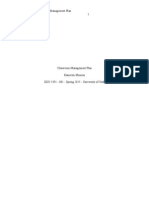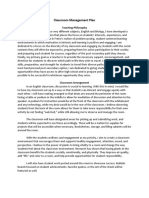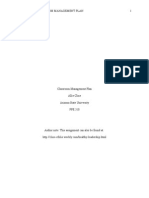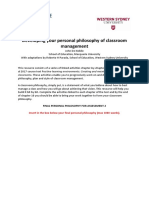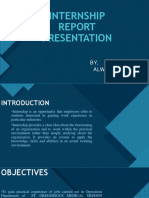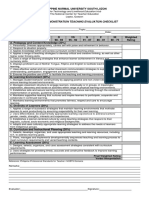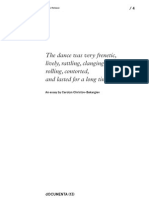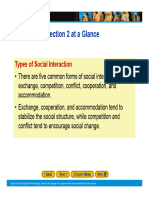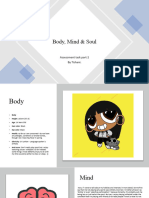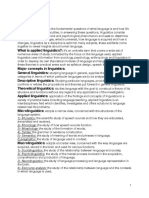Classroom Management Plan
Classroom Management Plan
Uploaded by
hunsp002Copyright:
Available Formats
Classroom Management Plan
Classroom Management Plan
Uploaded by
hunsp002Copyright
Available Formats
Share this document
Did you find this document useful?
Is this content inappropriate?
Copyright:
Available Formats
Classroom Management Plan
Classroom Management Plan
Uploaded by
hunsp002Copyright:
Available Formats
Richard Hunsperger EDSS 511 October 1, 2012 Classroom Management Plan Introduction: My classroom management strategies will reflect
my basic educational philosophy of postmodernism. My preventative approaches mainly involve implementing support methods for students and creating a healthy classroom environment. My supportive approaches involve giving students a voice in the classroom, something that we have rarely seen in the past. This idea, presented by Kohn in Beyond Discipline, is crucial for a classroom to be a respectful, professional workplace for students. Last, my corrective approaches involve disciplining students while focusing on the positives of each situation. Preventive Approach: My preventative approach with regards to classroom management will involve creating a positive learning environment where a classroom community is present. Students will feel comfortable in the community and hold respect for themselves, the teacher, and other students. In turn, I plan on having students become responsible for their own actions and take ownership over their misbehavior. This strategy is rooted within the postmodern philosophy, where students are given the power to take their own actions but must own what they act. The preventative approach to classroom management is very powerful and I plan to use the following strategies to inhibit student misbehavior while supporting student learning and motivation: 1. Develop rules to guide the class (Gordon, 1989). Having a set of rules provides a foundation for disciplinary actions. In my educational philosophy, a strong foundation of high expectations motivates students to behave and positively engage in the classroom. When students are exposed to set of rules to follow (especially via visual aid), they are more likely to remember to stay on task and do the work. 2. Concentrate on removing the causes of misbehavior (Charles, 2000). Removing the causes of misbehavior is almost always the best solution in the category of preventative approach. This strategy is more abstract and much harder to achieve than many of the other strategies. A concrete example for this is not allowing students to use any electronic devices (such as iPods and
Richard Hunsperger EDSS 511 October 1, 2012 cell phones) during class time. This will keep students on task and prevent distractions. 3. Develop a sense of community in the classroom (Kohn, 1996). Developing a sense of community in my classroom will promote positive, healthy interactions between students. These interactions will in turn promote respect, dignity, and diversity. Students will then feel less of an urge to misbehave and my classroom will be less disruptive as a result. 4. Motivate a sense of responsibility, self-control, and inner discipline (Gordon, 1989). Students who have a sense of responsibility and self-control are often much more academically successful than student who do not. I will give students the opportunity to volunteer for classroom tasks that support responsibility. I will also put students in groups often during my lessons and require each student be responsible for one role within the group. These students will not want to let their classmates down and become motivated to behave and stay on task. 5. Help students understand that there are no excuses for misbehavior and that they must take ownership for their actions. Misbehavior will not be an option in my classroom; there will be consequences for certain actions. I will tell students that there is no excuse for misbehavior and that they will be required to take ownership for their actions. One such example is swearing; students today seem to swear regularly and I will not tolerate it. Those students will be held accountable for punishments. Supportive Approach: My supportive approach to classroom management will involve treating the students with respect and giving them a voice in the classroom. It will also involve polished lesson plans and activities where I place a focus on the diversity of all learners in the classroom. All students will be supported when they need help and I plan to have a support structure in place before I start teaching. The postmodern education philosophy supports these ideas because it is concerned with truth and the languages/messages sent by the teacher. I am interested in sending positive signals to students and expressing to them that I am always truthful and never deceptive. The following strategies will implement my supportive approach:
Richard Hunsperger EDSS 511 October 1, 2012 1. Hold class meetings where students can express their opinions on the class (Albert, 1996). Using regular classroom meetings I will create a supportive environment where students are given the opportunity to express their opinions on the way the classroom is run. Giving students a voice allows them to feel more like they belong in the classroom and will support their good behavior. 2. Provide a secure, positive learning environment where students can experience a safe haven. A secure, positive learning environment is crucial to the success of all students. Students must feel comfortable and secure in the classroom so that they are able to pay attention and are not easily distracted. The safe haven part of the strategy involves creating an environment where students are open to talk with any time about any subject. Having this opportunity will help students feel at ease in my classroom and keep them motivated to succeed without worrying about some outside factors. 3. Ensure that students needs are met through polished lesson plans that address students from all walks of life. By creating polished lesson plans that support diversity, I will have implemented a network of support for diverse students through which I can recognize the needs of each student and take tangible steps toward meeting those needs. These polished lesson plans are difficult to create, however, and I do not expect to have all of them in place right away. 4. Use the idea of constructive teaching where students are allowed to make and learn from their mistakes and the teacher provides constructive feedback (Charles, 2000). Mistakes are essential to learning and it is time that students are taught this idea. Students will be allowed to make certain mistakes, both academic and nonacademic. There will be a limit to the nonacademic mistakes so that students do not take advantage of the system. The academic mistakes will be much more lenient and students will be encourage to view their mistakes as learning experiences. This will provide the support necessary for all students to experience academic growth.
Richard Hunsperger EDSS 511 October 1, 2012 5. Use getting to know you activities often so that students build bonds with their peers and kindness and collaboration are promoted regularly (Kohn, 1996). Building bonds in the classroom is essential to a supportive learning environment. Students need to have relationships with their peers so that they themselves have a support structure to fall back on. I will give activities that develop these relationships and allow students to build bonds with their classmates that will hold long after class has ended. 6. Create a learner-centered classroom (Kohn, 1996). A learner-centered classroom plays a key role in supporting student behavior. I will cover the walls with student work, position chairs and desks to maximize collaboration and provide comfortable areas for students to work. I will work with students on an individual level and use a respectful tone with students at all times. I will differentiate by having different students do different things throughout the lesson and class period. 7. Take steps to encourage students to play the game (Towbin, 2010). Motivating students to participate in class and play the game of school is extremely important. I will not use referrals and detention as a first line of defense, but rather implement strategies that motivate students to avoid misbehavior. Some strategies include making connections between what happens in school and happens in life, focusing on inquiry where I get to know students and discover who they are, and negotiating and compromising with students to find common ground where students are motivated to work. Corrective Approach: The corrective approach to classroom management is crucial to the efficiency of the way that the classroom runs. From the time students enter class to the time they leave they are expected to adhere to rules set by the teacher/students and the school. To maintain this, students must be corrected when they violate any of the rules. With postmodernism, I will demonstrate power over the students to reduce the amount of opposition. The following strategies outline what I consider to be proper ways of correction. 1. Use eye contact and polite words to inform students of what you want from them and what the consequences are for disobedience (Coloroso, 1994).
Richard Hunsperger EDSS 511 October 1, 2012 Many students are still children and the school system does not view them as adults. In my classroom, I will lay out in plain and polite words what I expect from students at all times while they are in my classroom. Eye contact will play a key role in doing this, it will show students that I am serious without me having to raise or change my tone. 2. Practice consistency when implementing corrective approach strategies (Canter 1976). Consistency is a big factor for corrective approach in every classroom. The teacher must consistently give punishments and consequences to each student who misbehaves. This consistency promotes fairness and structure in the classroom and extends the idea to students that each student is treated equally and no one is given special treatment. Consistency is where I will place most of my effort with regards to the corrective approach. 3. Develop a hierarchy of discipline where an equal amount of effort is present for both good and bad behavior (Mendler, 1983). By developing a hierarchy of discipline, I plan to use a no questions asked approach where bad behavior is punished and good behavior is rewarded. This approach relates to the supportive approach where I tell students that there are no excuses for bad behavior. The lower levels of the hierarchy will be for small misbehavior and warnings will usually be given. The extreme would be for reportable misbehavior involving violence or other acts. Good behavior will be rewarded mostly with praise from me in front of the class, hopefully motivating other students to behave and stay on task. 4. Implement a systematic approach of discipline where student dignity and hope are left intact (Mendler, 1983). Disciplining students with dignity is important to me. It is my goal not to berate students and call them out in front of the class. A systematic approach to discipline will help with this. Students who misbehave will be dealt with using a system of approaches that support dignity and hope. These approaches will give students the opportunity to realize that there is always hope for improvement. 5. Amidst punishments, find opportunities to recognize positive behavior.
Richard Hunsperger EDSS 511 October 1, 2012 Recognizing positive behavior is the best way to show students that there is hope for them to succeed and do well. Students who receive punishments and consequences for their actions must be shown the good in their behavior so that they have some motivation to do better next time. Each time I discipline a student I will try to remember a different time where that student did better behaved, and was engaged in the classroom. I will then remind that student that they were good at one time and can do it again. Conclusion: The management plan I have created will be ready to deal with students from all backgrounds and experience levels. From the very first day of class students will know that I am in charge but am giving them a voice in the classroom. Students can express their opinions to me in classroom meetings and together we will collaborate to create an ideal learning environment. Any misbehavior will be dealt with quickly and the positives of each situation will exploited. My postmodern philosophy fits in well with this plan, my students will be able to freely express themselves and use their creativity to solve problems while I send positive signals and lend support.
You might also like
- 1-513 Week 2-Clinical Field Experience B - Supporting A Positive Student-Centered CultureDocument7 pages1-513 Week 2-Clinical Field Experience B - Supporting A Positive Student-Centered Cultureapi-551836854No ratings yet
- Pple Assessment 2 FinalDocument16 pagesPple Assessment 2 Finalapi-484548620No ratings yet
- Pocket REBT 4 TherapistsDocument256 pagesPocket REBT 4 TherapistsCătălina Poiană100% (4)
- Behavioral Learning TheoriesDocument34 pagesBehavioral Learning TheoriesJenevyG.Manuel100% (3)
- CMN 412 Syllabus S 16Document8 pagesCMN 412 Syllabus S 16Carlos GuiterizNo ratings yet
- Overcoming Shyness PDFDocument38 pagesOvercoming Shyness PDFChizzy David .ONo ratings yet
- End Focus and End Weight PrinciplesDocument12 pagesEnd Focus and End Weight PrinciplesAlinaAdrianaNo ratings yet
- Final Copy David Philo Unit 102082 Philosophy of Classroom Management Document R 2h2018Document15 pagesFinal Copy David Philo Unit 102082 Philosophy of Classroom Management Document R 2h2018api-408497454No ratings yet
- Edu 5391 Classroom Management Plan Kameron MDocument11 pagesEdu 5391 Classroom Management Plan Kameron Mapi-281290748No ratings yet
- Student and Teacher Interaction HandbookDocument15 pagesStudent and Teacher Interaction HandbookWeleyNo ratings yet
- Classroom Management PlanDocument3 pagesClassroom Management Planapi-451769750No ratings yet
- Discovery LearninddavutDocument6 pagesDiscovery Learninddavutapi-340622406No ratings yet
- Assignment 501 Task BDocument4 pagesAssignment 501 Task Bfrediizee Wins100% (1)
- Sed464 Safinal CwiattDocument19 pagesSed464 Safinal Cwiattapi-456058932No ratings yet
- Classroom Management PlanDocument14 pagesClassroom Management Planapi-279826698No ratings yet
- Portoflio Classroom Management PlanDocument9 pagesPortoflio Classroom Management Planapi-242204661No ratings yet
- Trauma-Sensitive InquiryDocument21 pagesTrauma-Sensitive Inquiryapi-539554280No ratings yet
- Rachel Mersons Classroom Management PhilosophyDocument7 pagesRachel Mersons Classroom Management Philosophyapi-542540778No ratings yet
- Classroom Management PlanDocument3 pagesClassroom Management Planapi-213679164No ratings yet
- Statement of Informed Beliefs Essay-HortonDocument7 pagesStatement of Informed Beliefs Essay-Hortonapi-267730624No ratings yet
- Domain 2Document7 pagesDomain 2api-363984140No ratings yet
- Philosophy of EducationDocument5 pagesPhilosophy of Educationapi-562371166No ratings yet
- Standard 6Document7 pagesStandard 6api-519224747No ratings yet
- Signature Assignment FinalDocument16 pagesSignature Assignment Finalapi-630269063No ratings yet
- RM2 - Activity 1 (Educ100)Document3 pagesRM2 - Activity 1 (Educ100)John Daniel DavidNo ratings yet
- Artifact 3-5Document31 pagesArtifact 3-5api-419010396No ratings yet
- Personal Plan For Promoting Appropriate Student BehaviorDocument6 pagesPersonal Plan For Promoting Appropriate Student Behaviorapi-253265790No ratings yet
- Synthesis Reaction Paper 1Document4 pagesSynthesis Reaction Paper 1api-353957387100% (1)
- CMPDocument19 pagesCMPapi-242668635No ratings yet
- Task 1-Classroom Management TheoriesDocument10 pagesTask 1-Classroom Management TheoriesAfiq AfhamNo ratings yet
- Artifact 1 Standard 3Document6 pagesArtifact 1 Standard 3api-282066793No ratings yet
- Learning EnvironmentsDocument6 pagesLearning Environmentsapi-314913027No ratings yet
- Article 1 - Learing TheoriesDocument5 pagesArticle 1 - Learing TheoriesKavitha AlwisNo ratings yet
- Behaviour Management PlanDocument5 pagesBehaviour Management Planapi-299034986No ratings yet
- Philosophy LogDocument13 pagesPhilosophy Logapi-355889713No ratings yet
- Alignment of Management Philosophy Theory PlanDocument8 pagesAlignment of Management Philosophy Theory Planapi-357949761No ratings yet
- Classroom Discipline PlanDocument6 pagesClassroom Discipline PlanCandice AndyNo ratings yet
- Cline Allie Fall2015 CMPDocument5 pagesCline Allie Fall2015 CMPapi-285105493No ratings yet
- Classroom Management FinalDocument13 pagesClassroom Management Finalapi-711296025No ratings yet
- Portfolio Activity Unit 2Document6 pagesPortfolio Activity Unit 2SarimuNo ratings yet
- PhilosophyofteachingDocument3 pagesPhilosophyofteachingapi-353448090No ratings yet
- CM PhilosophyDocument5 pagesCM Philosophyapi-532628985No ratings yet
- My Classroom Management Plan Villar PostradoDocument6 pagesMy Classroom Management Plan Villar PostradoNyca PacisNo ratings yet
- Assignment 2 Part BDocument16 pagesAssignment 2 Part Bapi-374903028No ratings yet
- Essay WritingDocument7 pagesEssay Writingjoey yongNo ratings yet
- ELC 102 Episode 5Document3 pagesELC 102 Episode 5renz taniguchiNo ratings yet
- Classroom Management Plan Philosophical Model of Classroom Management and DisciplineDocument10 pagesClassroom Management Plan Philosophical Model of Classroom Management and Disciplineapi-280368887100% (1)
- LunsfordDocument27 pagesLunsfordapi-435713713No ratings yet
- Project 3Document7 pagesProject 3api-290777581No ratings yet
- Personal ReflectionDocument3 pagesPersonal Reflectionapi-357631525No ratings yet
- Inbound 5434020892549116513Document8 pagesInbound 5434020892549116513Roselle Luzano GalugaNo ratings yet
- Classroom Management PlanDocument8 pagesClassroom Management Planapi-215298509No ratings yet
- Edi 638-ClassroomenvironmentplanDocument7 pagesEdi 638-Classroomenvironmentplanapi-389267414No ratings yet
- Mirriam Moyo HLS DocumentDocument3 pagesMirriam Moyo HLS DocumentMirriamNo ratings yet
- Classroom Mangement PlanDocument9 pagesClassroom Mangement PlanBrien BehlingNo ratings yet
- Unit 2 Prtfolio SubmissionDocument6 pagesUnit 2 Prtfolio SubmissionAni JonesNo ratings yet
- Classroom Management PlanDocument7 pagesClassroom Management Planapi-331296700100% (1)
- Lesson 4 Beetc 680Document5 pagesLesson 4 Beetc 680ayeshastudies888No ratings yet
- Pdhpe Lesson 2C Safety PlanDocument3 pagesPdhpe Lesson 2C Safety PlanFinapapNo ratings yet
- Classroom Management Dissertation PDFDocument4 pagesClassroom Management Dissertation PDFBuyACollegePaperCanada100% (1)
- Task 2. Critical AnalysisDocument8 pagesTask 2. Critical AnalysisHulk Hijau100% (1)
- Classroom Management Ed 698 Gillian Edwards 2020Document17 pagesClassroom Management Ed 698 Gillian Edwards 2020api-354856291No ratings yet
- Morning Meetings for Special Education Classrooms: 101 Fun Ideas, Creative Activities and Adaptable TechniquesFrom EverandMorning Meetings for Special Education Classrooms: 101 Fun Ideas, Creative Activities and Adaptable TechniquesNo ratings yet
- Classroom-Ready Resources for Student-Centered Learning: Basic Teaching Strategies for Fostering Student Ownership, Agency, and Engagement in K–6 ClassroomsFrom EverandClassroom-Ready Resources for Student-Centered Learning: Basic Teaching Strategies for Fostering Student Ownership, Agency, and Engagement in K–6 ClassroomsNo ratings yet
- Humanizing Classroom Management: Restorative Practices and Universal Design for LearningFrom EverandHumanizing Classroom Management: Restorative Practices and Universal Design for LearningNo ratings yet
- Math Analysis Chapter 5 JeopardyDocument30 pagesMath Analysis Chapter 5 Jeopardyhunsp002No ratings yet
- Biology Mathematics History Objective Objective Objective: 1.0 Students Know TheDocument6 pagesBiology Mathematics History Objective Objective Objective: 1.0 Students Know Thehunsp002No ratings yet
- Classroom NewsletterDocument1 pageClassroom Newsletterhunsp002No ratings yet
- Excel Crossword PuzzleDocument1 pageExcel Crossword Puzzlehunsp002No ratings yet
- Discharge PlanDocument2 pagesDischarge PlanEulz Neil100% (1)
- ALWIN INTERNSHIP REPORT (Autosaved)Document13 pagesALWIN INTERNSHIP REPORT (Autosaved)Elizabeth ThomasNo ratings yet
- General Demonstration Teaching Evaluation ChecklistDocument1 pageGeneral Demonstration Teaching Evaluation ChecklistJayson Alvarez MagnayeNo ratings yet
- A. Mr. Speed and Ms. Roberts Mutually Assumed Marital Rights, Duties, and ObligationsDocument4 pagesA. Mr. Speed and Ms. Roberts Mutually Assumed Marital Rights, Duties, and ObligationsaquyenlNo ratings yet
- ACCA December 2009 Examiner Report P5Document3 pagesACCA December 2009 Examiner Report P5Mansoor JanjuaNo ratings yet
- A Review of Spiritual HealthDocument6 pagesA Review of Spiritual HealthkhorhuiyinNo ratings yet
- Decision Making Under Uncertainty - FinalDocument21 pagesDecision Making Under Uncertainty - FinalWeng FléursNo ratings yet
- 4 - An Essay by Carolyn Christov-BakargievDocument16 pages4 - An Essay by Carolyn Christov-BakargievSilva KalcicNo ratings yet
- Chapter 3 - Social Structure - Section 2 - Types of Social InteractionDocument8 pagesChapter 3 - Social Structure - Section 2 - Types of Social InteractionBassem AdelNo ratings yet
- English 6 - Quarter 4 - Module 8 - Revising The Persuasive EssayDocument16 pagesEnglish 6 - Quarter 4 - Module 8 - Revising The Persuasive Essaydarla byrne camongolNo ratings yet
- Pendulum LabDocument2 pagesPendulum Labapi-208139785No ratings yet
- A para VidyaDocument1 pageA para VidyamascaNo ratings yet
- Lección 22 - How Well + IntensifiersDocument4 pagesLección 22 - How Well + IntensifiersHanne J. Bayeh VillarrealNo ratings yet
- Nyas12206How Memoirists Mold The TruthDocument2 pagesNyas12206How Memoirists Mold The TruthcgrossNo ratings yet
- Portfolio Vivekananda Kendra Vidyalaya, Nalbari Class: X Sub: Information Technology SESSION: 2022-2023Document4 pagesPortfolio Vivekananda Kendra Vidyalaya, Nalbari Class: X Sub: Information Technology SESSION: 2022-2023Lunaria VirousenNo ratings yet
- The Principles of Occupational HealthDocument20 pagesThe Principles of Occupational HealthSteven CuadraNo ratings yet
- Cantonese Aphasia Bank - Question Bank, Score Sheet - CAB - Yiu, 1992Document10 pagesCantonese Aphasia Bank - Question Bank, Score Sheet - CAB - Yiu, 1992fpNo ratings yet
- Presentation 6Document8 pagesPresentation 6Mukesh KundalNo ratings yet
- R.E Assessment Mind Body and Soul (ABOUT ME)Document5 pagesR.E Assessment Mind Body and Soul (ABOUT ME)shani.No ratings yet
- ChakrasDocument35 pagesChakrasMahesh71% (14)
- Applied Linguistics SummaryDocument20 pagesApplied Linguistics SummaryAyoub yopiNo ratings yet
- Utilization of Learning Resources and It's Effect On Academic Performance of StudentsDocument7 pagesUtilization of Learning Resources and It's Effect On Academic Performance of StudentsQuadri olawale alegiNo ratings yet
- Industrial RelationsDocument21 pagesIndustrial RelationsKuthubudeen T MNo ratings yet
- 395954809-PJ-Saher-Complete-Zenyoga-PDF (1) - (2) - (2) - (2) - (2)Document31 pages395954809-PJ-Saher-Complete-Zenyoga-PDF (1) - (2) - (2) - (2) - (2)make Joke ofNo ratings yet
- Math6 DLPDocument8 pagesMath6 DLPSatria SakilanNo ratings yet








